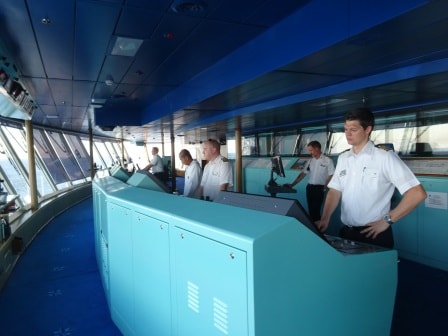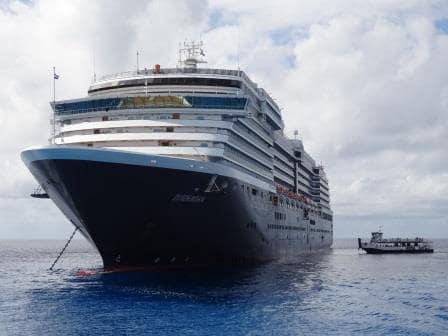After leaving Half Moon Cay, we sailed for most of the afternoon and evening south through and between the larger islands of the Grand Bahama Bank. Then we crossed the Eastern end of the Old Bahama Channel and dived into the Windward Passage and by 06.00 we had Haiti on our portside and Cuba on our starboard side. The Windward Passage is very wide and fairly long and it took until noon time before we cleared the south west point of Haiti and entered the Caribbean Sea which we will keep crossing on a south westerly course until we reach Aruba tomorrow afternoon. We have a strong easterly trade blowing which is under a relative angle about half on our portside and that gives a combined wind of about 45 miles per hour over the deck. Luckily the ship has glass wind breakers everywhere and that makes it possible to sit nicely out of the wind and in the sun.
Navigation has changed considerably in the last 10 years and not only because of all the gadgets which are nowadays available. Of course we have GPS now, positioning by means of satellites and that has gotten better every year. In 1986 when I came across the first GPS we were happy for half a mile of accuracy every three hours or so. Then this distance dwindled to 100 feet, then to 3 feet and now with the newest systems it is down to a few inches. And then there are a plethora of other instruments available such as the radar and the electronic chart. Also those are getting better and better all the time and sometimes the captains have to remind the navigators that looking out of the window is still considered part of the safe navigation.

The Zuiderdam bridge team. Far left Administrator, then Helmsman, then Navigator (Staff Captain) and the the Co-Navigator (First Officer). In the back Captain Turner as Operations Director.
What has also changed is the way the bridge is manned. With so many gadgets available, which all can go wrong, you have to set up the bridge team in a different way. Especially when going in and out of port. In the past the Master had a wise conversation with the pilot and then the pilot conned the ship into port. They still do, but less and less as they do not know all this fancy equipment in detail. So the pilot has to be an integral part of the bridge team who brings his specific local knowledge, but he/she needs the knowledge of the bridge team to operate the complex bridge system and get the ship where it has to go.
As a result the bridge setup has been completely revamped and the various functions rotate over the bridge team members present. The captain is still in command and when he is part of the team he will always carry “The Charge” indicating that he has overall command. That does not mean that he is doing anything himself, he might just be monitoring what the rest of the team is doing.
The team consists out of
- The Operations Director = he/she who is overlooking the whole operation and does the communication during docking.
- The Navigator = the officer who is conning the ship and when the ship comes alongside, docks the ship. This could be the captain but not necessary so. The captain might decide that the Staff Captain is doing it, or another officer. The captain does keep “ The Charge”
- The Co-Navigator. = the supporting officer who monitors the Navigator to ensure everybody stays with the voyage plan. Nav. and Co – Nav. discuss each course change, speed change, each evolution they want to embark upon before doing it.
- The Administrator= who keeps the log book, answers the telephones and monitors the alarms of the Safety Centre.
- The final members of the team are The Helmsman and The Look-out.
Once the ship is out of port, Navigator, Co-Navigator, helmsman and Look out remain and the Captain, administrator and staff Captain leave. The captain hands over “The charge” to the officer who is or becomes the Navigator. By doing that it is always clear who is in charge on the bridge. If the captain later comes back for a cup of coffee, then it does not mean that he suddenly has a direct say in what is going on, on the bridge. He has to get back into the Team, familiarize himself with the situation and then take the charge back.
The whole reason for this team setup is to reduce mistakes. There are always one or more officers watching over each other’s shoulders. A sort of human redundancy and it works very well.
Tomorrow morning we are still at sea and then by 1 pm. we should be in Aruba with what looks like another warm and sunny day. 29oC / 84oF does not exactly indicate cold weather.


November 13, 2015 at 5:30 pm
Captain Albert
That was a fascinating look at the discipline on the bridge. Do the officers take turns bringing the ship along side or sail away so as to maintain currency for these functions?
Thank you,
Roger T
November 14, 2015 at 4:56 pm
Thank you for reading my blog.
No, the functions of the bridge team stay the same. The persons who will assume each function, might change. It is always the person who has the navigator role, who maneuvers. If the captain does the manuver then he will act as the navigator and somebody else will be the Operations Director keeping the overview. I have seen captains also acting as Co-navigator and looking after the log book when it was a good idea to have another navigator – operations director team. But what ever the team composition is, the Captain always has “the charge” when he is part of the bridge team.
Best regards
Albert
August 20, 2022 at 12:44 pm
I’d like to ask you a question about this:
I saw, always in your blog, that sometimes there was the staff captain handling communications with the mooring teams and the captain taking a “supervisory role”, while another officer was the navigator, conning the ship.
This means that, in those cases, the staff captain was the operation director (since he was at the communications, and so the Captain was in a sort of “mentor role”) or the Captain was the OD (since he had a supervisory role).
Could you explain this to me, please?
Thanks a lot!
August 23, 2022 at 12:59 pm
Good morning,
thank you for your comment.
The old days set up was always: Captain maneuvers, Staff Captain/ chief officer communication, Officer of the watch monitors the navigation & safety. Asst of the watch answers telephones and writes the log book.
With the arrival of BRM and the willingness of the company’s to not directly blame the captain if there was a dent made, things changed. So now with us it works as follows:
Inclement /critical weather /port:
Captain maneuvers =
Staff Captain = Operations Director
OOW: , communications, unless experienced and can handle the OD job
AOW: runs the bridge.
The easier the port and or the weather, the more variation is possible and this sees that even the person who is the junior on the team manoeuvres/ docks the ship. Thus “the Conduct” can be rotated around, but the captain always keeps “the Charge” when part of the team.
I hope this helps
Best regards
Capt. Albert